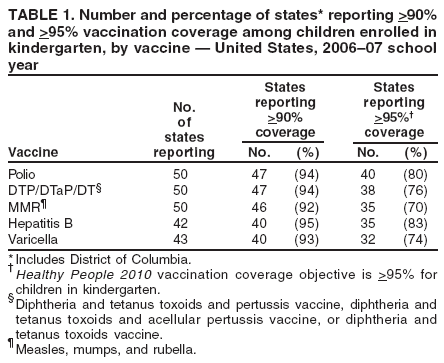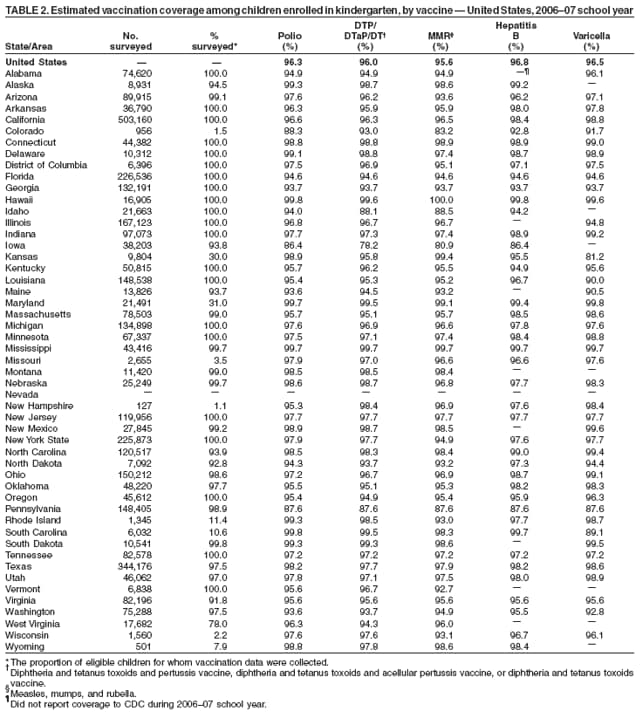 |
|
|
|
|
|
|
| ||||||||||
|
|
|
|
|
|
|
||||
| ||||||||||
|
|
|
|
|
Persons using assistive technology might not be able to fully access information in this file. For assistance, please send e-mail to: mmwrq@cdc.gov. Type 508 Accommodation and the title of the report in the subject line of e-mail. Vaccination Coverage Among Children in Kindergarten --- United States, 2006--07 School YearHealthy People 2010 objectives include increasing vaccination coverage among children in kindergarten and first grade (objective 14-23). For these children, the target is >95% vaccination coverage for the following: hepatitis B vaccine; diphtheria and tetanus toxoids and pertussis vaccine, diphtheria and tetanus toxoids and acellular pertussis vaccine, or diphtheria and tetanus toxoids vaccine (DTP/DTaP/DT); poliovirus vaccine; measles, mumps, and rubella (MMR) vaccine; and varicella vaccine (1). To assess progress toward national goals and determine vaccination coverage among children in kindergarten, data were analyzed from reports submitted to CDC by 49 states and the District of Columbia (DC) for the 2006--07 school year (2).* This report summarizes findings from that analysis, which indicated that approximately 75% of states have reached the 2010 objective of at least 95% coverage for all of the vaccines recommended by the Advisory Committee on Immunization Practices (ACIP) for children in kindergarten. These results underscore the effectiveness of school-entry requirements in increasing vaccination coverage but highlight a need for more standardized vaccination reporting among states. To determine vaccination coverage, up-to-date status was defined by the vaccines and doses required for school entry in each state rather than by the number of doses recommended by ACIP; the number of doses required to be up to date varies by state depending on timing of vaccinations, state and local area requirements regarding number of doses, and vaccine brands used. National estimates of coverage were calculated by weighting each state's coverage estimate according to the size of its kindergarten enrollment. For the 2006--07 school year, all states except Nevada submitted reports of vaccination coverage levels for children entering kindergarten. All 49 reporting states and DC assessed vaccination rates in public schools; 44 states also assessed rates in private schools, and six states also assessed rates in home schools. Thirty-five states reported coverage based on >95% of children enrolled in kindergarten, and seven states reported coverage based on a random sample of schools and students within schools; the remaining states attempted to gather data on all enrolled kindergarteners but obtained data on <95%. Health departments reviewed vaccination records to assess coverage in seven states, relied on data reported directly from schools in 29 states, and used some other method (e.g., combination of health department and school personnel or registry data) in 14 states. Among the reporting states, coverage ranged from 32 (74%) states with >95% coverage for varicella vaccine to 35 (83%) states with >95% coverage for hepatitis B vaccine (Tables 1 and 2). Although four states do not require or monitor mumps vaccination and one state does not require or monitor rubella vaccination, MMR usually is the vaccine of choice for protection against measles; therefore, children who receive this vaccine are protected against all three diseases. Thirty-five (70%) states reported >95% coverage for MMR. Thirteen of the reporting states did not meet the 95% coverage target for one or more of the vaccines. Reported by: C Stanwyck, PhD, N Jain, MD, Immunization Svcs Div, National Center for Immunization and Respiratory Diseases, CDC. Editorial Note:State laws requiring proof of vaccination at early school entry are key to the U.S. vaccination program and help ensure that no child is unvaccinated (3,4). The effectiveness of these laws depends on school nurses, teachers, health department staff members, and others identifying children whose vaccinations are not up to date. The findings from this analysis indicate that approximately 75% of states have reached the 2010 objective of at least 95% coverage for all vaccines recommended for children in kindergarten. The high nationwide coverage indicated in this analysis and other surveys in recent years underscore the success of school-entry requirements in boosting vaccination coverage. Childhood vaccination coverage also is measured nationally among children aged 19--35 months (5). Higher percentages of children are up to date at kindergarten entry than at younger ages, suggesting that early school-entry laws help maintain high coverage and ensure completion of the vaccine doses recommended for children by ages 4--6 years (5). The findings in this report are subject to at least four limitations. First, the vaccinations required and the methods for surveying kindergarten children vary substantially among states, which limits comparability of data. Second, results from states that assessed a small, random sample of students might be less precise than results from states that assessed all students; however, state sampling methods were reviewed and approved by CDC to increase the accuracy of estimates. Third, private schools and home schools were not surveyed by all states. Finally, incomplete reporting by certain states limits interpretation of these data. CDC is continuing to work with state immunization programs to improve certain state survey methods and standardize reporting of data. For example, CDC provided a standardized, online reporting system during the 2002--03 school year (2). CDC also has encouraged greater standardization of reporting by requesting that all states report coverage based on ACIP vaccination recommendations (6). In addition, CDC has reviewed state survey methods and developed preliminary recommendations for standardizing data collection and reporting. These preliminary recommendations will be revised as needed after consultation with state immunization programs. Additional information regarding assessing and reporting vaccination coverage among children entering school is available at http://www.cdc.gov/vaccines/stats-surv/schoolsurv/default.htm (2). References
* State vaccination reports for kindergarten children are required as part of federal immunization grant funding. Information on survey methods and reporting requirements is available at http://www.cdc.gov/vaccines/vac-gen/policies/ipom/default.htm.
Table 1  Return to top. Table 2  Return to top.
Disclaimer All MMWR HTML versions of articles are electronic conversions from ASCII text into HTML. This conversion may have resulted in character translation or format errors in the HTML version. Users should not rely on this HTML document, but are referred to the electronic PDF version and/or the original MMWR paper copy for the official text, figures, and tables. An original paper copy of this issue can be obtained from the Superintendent of Documents, U.S. Government Printing Office (GPO), Washington, DC 20402-9371; telephone: (202) 512-1800. Contact GPO for current prices. **Questions or messages regarding errors in formatting should be addressed to mmwrq@cdc.gov.Date last reviewed: 8/16/2007 |
|||||||||
|